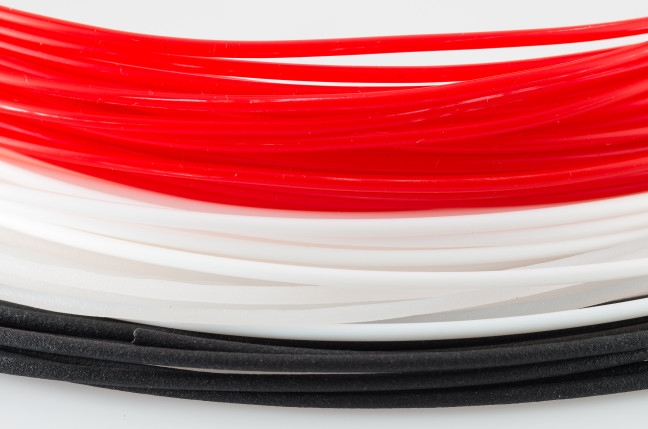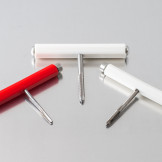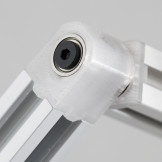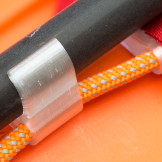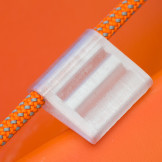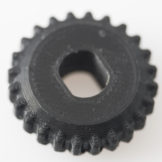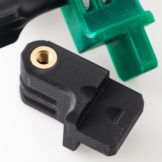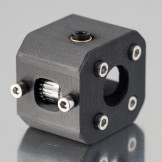For all the people who have asked about filaments, here's my list, spread across 8 different posts. This list includes over a hundred filaments, with pictures, measurements, and impressions. All are 1.75mm. Please don't read too much into my opinions, there's a lot of variation in filament and printers, and my opinions apply only to the spools I have on hand. I try to be objective with these opinions, but my preferences and biases affect my opinion, so keep that in mind when browsing this list. Also be aware of the date, some of these filaments may no longer be available, or may be different from what is currently available. I sometimes describe how I use and print some filaments just to provide another data point, it's likely that your optimal setup will be different from mine.
PLA | ABS | PETG | FLEXIBLE | NYLON | METAL | WOOD | OTHER
Diameter - Diameter readings are taken at several angles, across a meter or more of filament, at whatever part of the spool is currently accessible. Sometimes the filament diameter variation is the result of variations in roundness, and may not have a significant impact on printing performance. I've noticed that I've become less tolerant of filament diameter variation as printers get more precise, inconsistent layers or banding tends to overshadow filament diameter fluctuation. One exception is with transparent filaments, where irregular layers aren't very visible.
Color - It's hard to know the exact color, transparency, and texture of the filament when you're buying online. I'm hoping these pictures along with the descriptions will help you know what you're buying. All the pictures were lit with the same basic setup (unless stated otherwise) so the colors should be somewhat consistent across different types and brands. I have my monitors calibrated, and I try to adjust the pictures to match the actual filament as accurately as I can (which is not very accurately). I don't put the same effort into the example photos or photos that contain multiple spools.
Transparency - Transparency makes a big difference in how these filaments print, but it's one aspect that I hard time getting reliable info on. I'll use the following terms when describing the spooled filament. This info is subjective, the surface finish of the filament will affect the perceived transparency, but it should give you a rough idea.
- very high - Perfectly clear as far as I can tell, ignoring any color.
- high - It's translucent, with a significant amount of fogginess or haziness.
- moderate - It's opaque enough that it doesn't appear to be transparent, but light shines through it fairly easily. If you press a bright flashlight against the spool of filament, about half of the spool will light up. Infill is usually visible through one or two shell layers.
- low - It's opaque enough that you probably won't see your infill showing through, but transparent enough to deemphaasize layer lines. If you press a bright flashlight against the spool of filament, you will see a large halo of light around the flashlight from the light filtering through the filament.
- none - Completely opaque. If you press a bright flashlight against the spool of filament, you will see very little if any light bleeding through the filament.
Printers - I use a Eustathios Spyder v2 and a Rigidbot, both running E3D v6 Hotends. The Rigidbot uses Printrbot gear head direct drive, the Eustathios uses a short bowden setup with a Bondtech extruder (160mm from gear to nozzle). Both are fixed gap, symmetric grip, high torque extruders, so for the most part, all the filaments listed feed without jamming or clogging, (there are a few exceptions, like running metal powder filament through a 0.3mm nozzle or trying to print with cleaning filament). I also used to own an Afinia H-Series Printer (US version of the Up! Plus), only a few of these filaments work well with that printer out of the box. All the example prints have been printed on these three printers. Keep in mind that filament isn't the only factors affecting print quality, choice of printer, experience, print settings, choice of slicer, etc. can have a bigger impact than the filament.
Environment - I'm not sure how much the ambient environment affects printing, but I live in San Francisco Bay Area, California, USA. Temperature and humidity is moderate, indoor temperatures range from a low of 45°F / 7°C in the winter to a high of 80°F / 27°C in the summer with normal temperatures around 65°F / 18°C. None of my printers are enclosed.
Links - There are affiliate links in this list, I may receive a small percentage of the total if you place orders soon after using the links (at no cost to you). I've marked all affiliate links with an asterisk (*). Many thanks to all who have been using these links! Normally I only link to products I'd buy again, but for convenience and completeness, I'm linking all the filaments I can find a reputable source for (even the really bad ones, so read the description). I usually link Amazon* when possible, unless I know of better sources for that particular item.
Other
Polymaker PolyMax PLA | Red | 2015
Diameter: 1.73 – 1.81 | Transparency: None | Origin: China
Bright vibrant red color. Polymax PLA is completely different from normal PLA, I’d say it feels a lot more like nylon in the way it feels. It isn’t elastic so that limits some of the potential uses. I haven’t used it enough to know how strong it is compared to nylon, but PolyMax seems like it’s easier to print with. The PolyMax printed taps in the picture are strong enough that I use them for tapping aluminum extrusions. Filament provided by PrintedSolid.
Polymaker PolyMax PLA | White | 2015
Diameter: 1.73 – 1.80 | Transparency: None | Origin: China
A nice opaque white color free of any color casts. See PolyMax Red above. Filament provided by PrintedSolid.
 Polymaker Support | White | 2015
Polymaker Support | White | 2015
Diameter: 1.69 – 1.83 | Transparency: Moderate | Origin: China
I don’t have a dual extruder set up so I haven’t tried this yet, but it has me tempted to try dual extrusion again. Filament provided by PrintedSolid.
 eSun Cleaning Filament* | White | 2014
eSun Cleaning Filament* | White | 2014
Diameter: ~1.4 – 1.9 | Transparency: Moderate | Origin: China
I didn’t understand why anyone would want to clean their nozzle with filament that costs more than the filament they’re using when I first heard of this, but I received some as a free sample and have found it useful. I’ll usually use it to flush out filament whenever I’m changing from a dark to a light or clear filament. For cleaning out the nozzle and heat break, I still prefer doing a cold pull with 618 nylon, but that takes significantly more time and effort. Filament provided by eSun and Intservo.
3D Supply Source Polycarbonate | Clear | 2014
Diameter: 1.67 – 1.73 | Transparency: High | Origin: China
As expected of polycarbonate, this filament warps more than ABS which makes it more challenging to print with. Getting dimensions accurate usually takes some iteration due to shrinkage, and I mostly use it for smaller parts. I don’t use polycarbonate very often but it’s a good option when I don’t think PETG will be strong enough and I need something more rigid and elastic than nylon. I pretty much only print it at 100% infill. There are some new lower temperature polycarbonate formulations available now, but I haven’t tried them and I don’t know if they’re as strong.
Atomic Filament | Black Carbon Fiber ABS | 2016
Diameter: 1.71 – 1.74 | Transparency: None | Origin: USA (California)
Slightly less glossy than Atomic Filament Carbon Fiber PETG.
Atomic Filament | Black Carbon Fiber PETG | 2016
Diameter: 1.71 – 1.74 | Transparency: None | Origin: USA (California)
More glossy than the Atomic Carbon Fiber ABS and Colorfabb Carbon Fiber XT. Significantly more flexible and less brittle than Colorfabb XT.
Colorfabb Carbon Fiber XT* | Black | 2015
Diameter: 1.76 – 1.80 | Transparency: None | Origin: Netherlands
Prints with an attractive rough matte texture that looks good does a good job of hiding the layer lines. It’s significantly more rigid than the Atomic Carbon Fiber PETG, but it’s also very brittle.
ProtoFlux Magnetic Filament | Black | 2014
Diameter: ? | Transparency: None | Origin: USA (OR)
I haven’t printed with it, but I can barely detect any attraction to rare earth magnets. If you want a filament that sticks to magnets, you might want to try ProtoPasta’s magnetic iron instead.
Notes on filament brands:
Atomic Filament - They target 1.72mm as the average diameter of their 1.75mm filament (according to their FAQ) so that's usually a good default diameter for their filament, their PLA is usually consistent enough that you don't have to measure each spool. All their filaments are made in California (moved to Indiana in 2017) and they help support this site.
Colorfabb PLA/PHA* - The extra flexibility of PLA/PHA is great for thin, small, or flexible parts that would be too fragile to hold up with regular PLA. It also prints with a satin finish that looks better than the glossy finish I usually get with PLA. Despite the PHA content, I classified PLA/PHA with the other PLA filaments as these differences are fairly subtle and it prints with similar settings.
eSun* - eSun filament is sold and sometimes rebranded by a lot of different sources and I don't know if there are differences between them other than the different spool styles. For this list, I assume they're the same. Microcenter's Inland filament is currently eSun filament and the cheapest place I've found for it (if you don't account for shipping). They also sell Inland* filament on Amazon with free prime shipping. Most of the eSun filament in this list is from Intservo*, who sells on Amazon, but I have also ordered from Microcenter* and Prototype Supply*.
Inland Filament* - I assume all the Inland filament is from eSun (see eSun above) and I've mostly linked to Inland spools because it's cheaper and I prefer the solid black spools.
Honeycomb Drone* - Some spools are advertised as 3lb spools, but are standard 1kg spools. Prices fluctuate on Amazon, I've seen prices under 10 and over 40 USD. The spools I ordered were between 9 and 14 USD.
3D Solutech* - Proudly claims that "All our materials are purely grow and made in the USA", but the spools and the labels under their stickers are identical to other filament I own that came from China.
Places to buy filament:
Amazon* - One of the best places to buy filament, I believe they even accept returns if you don't like the filament (I haven't tried that myself, that's partially why I have so much of it).
Printed Solid - They only sell the good stuff (Colofabb, Taulman, Fenner Drives, Polymaker, etc.), and are kind enough to send me some samples to try occasionally. They sell filament samples which are great for trying out some of the more expensive filaments. They also have a store on Amazon*.
Atomic Filament - Good filament, free shipping, made in California. I check their site often as they're adding new colors / types regularly.
Microcenter - Good place to order eSun (branded as Inland) filament if you have a store nearby or are ordering large quantities (Shipping where I'm at starts at $6 and increases by $1 per spool). They also sell on Amazon* with free prime shipping.
